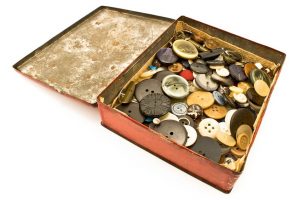Road Trip Through History: Button, Button, Who’s Got the Button
The nineteenth century button industry based on fresh-water mussels was a recurring theme of our ten days on the Great River Road this year.
In 1891 a German button manufacturer named John Frederick Boepple opened a button factory in Muscatine, Iowa, after a change in tariff laws caused his business in Germany to fail. Shell buttons weren’t new. The Boepple family had made buttons from shells and horn for many years. But the plentiful mussel shells found in the Mississippi River near Muscatine were thick and well suited for cutting into buttons.
At the time that Boepple opened his small factory, the McKinley tariff of 1890 meant that imported shell buttons were expensive. The original foot-operated lathes that Boepple adapted from those used to make buttons from ocean shells were designed to allow skilled craftsmen to create a button from beginning to end, which meant that even without the additional cost of the tariff buttons were not cheap.* With the introduction first of steam-powered lathes and then a revolutionary machine called the Double Automatic that, well, automated the process, attractive mother-of-pearl buttons were affordable to the average household. By the late nineteenth century, buttons made from river mussel shells were so popular that bars in at least one river town accepted mussel shells as payment.
Like other industries along the Great River Road, buttons were a boom and bust business. “Clammers” earned good livings harvesting shells from the river in large quantities. Button factories sprang up in towns up and down the Mississippi, creating hundreds of factory jobs and more opportunities for cottage industries where women and children sewed buttons to cards at home. In the same way that the logging industry overcut the great forests of Minnesota and northern Wisconsin, by the 1920s, the button industry had decimated the Mississippi’s mussel population, and precipitated its own demise.**
* Today we tend to think about buttons as nothing in particular. Or more accurately, unless you knit or sew, you probably don’t think about buttons at all unless you have to sew one back on your jacket. (A skill everyone should learn, in my opinion.) But historically buttons were a luxury item: made by hand and often from expensive materials. It turns out there was a good reason my grandmothers (and probably yours) kept a button jar. (For that matter, I still have one.)
For those of you who’d like to know more, I recommend this article:
http://www.slate.com/articles/life/design/2012/06/button_history_a_visual_tour_of_button_design_through_the_ages_.html
** The related story of efforts to restore the river mussel population was also a recurring theme of our trip. At one time there were 51 species of mussels in the upper Mississippi; today theater are 38, eighteen of them endangered.

Love the article.
There’s something odd about the link. Here’s where I found it. http://www.slate.com/articles/life/design/2012/06/button_history_a_visual_tour_of_button_design_through_the_ages_.html
Thanks for inspiring me to look harder at buttons!
Thank you for calling my attention to the problem with the link, and for tracking it down. I’ve fixed it now.